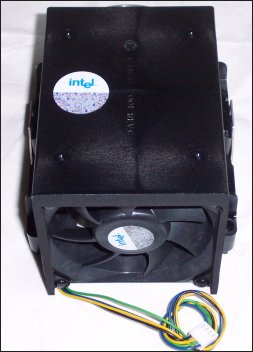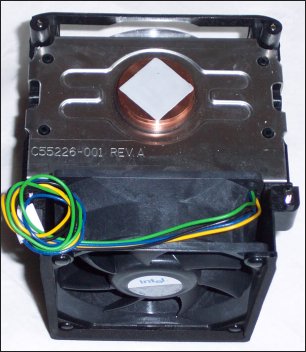BTX in the flesh
Show me BTX then
As you wish. I've been evaluating Intel's BTX demonstration kit for microBTX for the last few days. Intel supply a D915GMH mainboard - their only BTX mainboard product - and a Pentium 4 550 processor (3.4GHz), Type I thermal module for the processor and an AOpen B300 microATX desktop case.Intel have created reference thermal modules for BTX, the Type 1 being the larger of the two and designed for microBTX products. The Type II module is smaller in height, can't cool the entire range of Intel's Pentium 4 processor range like the Type 1 module can and is for picoBTX.
There's two types of Type 1 module, too. There's a stacked fin design with a large copper core, and then there's a spiral fin design around a large copper core. The spiral fin design is a more effective cooler but for the Pentium 4 550, the stacked design is all that's needed, Intel creating a thermal module for all of three processors in the rarified upper stratosphere of the Pentium 4 range, CPUs to which microBTX is unwholly suited.
BTX Type 1 Stacked Fin Thermal Module
Compared to the Pentium 4 processor that it's designed to be cooling, it's massive. Weighing 1.26 kilos (2.77lbs) with the shroud attached, the cooler is comprised of a series of aluminium disks attached to a copper core and base, via a baseplate. A fan and shroud attach to that base to create the full heatsink. The fan was designed using fluid dynamics (air is a fluid) simulations to make it efficient and quiet.
You can see the bottom of the fan protruding underneath the face of the heatsink. That seems to be the reason for most of its noise in terms of colliding airflow from that generated by the fan, onto the heatsink. More on that soon.
Intel D915GMH BTX Mainboard and Layout
Actually looking at a BTX mainboard gives you best idea of just how BTX works, thermally. Imagine that mainboard as you can see it, in a tower chassis. You can imagine three horizontal strips across the mainboard starting from the PCI Express and PCI I/O at the top, core logic and processor (with airflow driven by the thermal module), and the memory modules inside the strip zone at the bottom.
It's all laid out logically in that respect, bar the SATA ports which due to cable length and placement inside the central zone, seem in the wrong place.
That mainboard and thermal module interface like so. I've placed a Radeon X600 XT in the shot to give you an idea of scale as the CPU socket is covered.
You can see the thermal module interface with leftmost pair of mounting holes on the mainboard. The mount points are actually in the chassis on what Intel calls the Support Retention Module or SRM for short. The chassis is taking all the load for the thermal module, not the mainboard. That allows Intel to get away with a 1.26 kilo cooler without issue, even stood up in a tower case. As long as the mainboard is sitting correctly on the SRM, the heatsink's pressure on the processor can be maintained, the weight of it actually assisting somewhat in a flat desk chassis. Pressure on the processor remains high with the SRM and heatsink which, with a competent fan, means the heatsink is able to cope with the 100W+ heat loads of current and future Pentium 4 processors with consumate ease.
AOpen B300 Desktop BTX Chassis
Looking at the chassis, the mainboard sits in that right hand section with the fan side of the thermal module sliding just under the rubber shroud at the front of the case.
The shroud directs intake airflow from the front of the chassis and through the thermal module.
Here's an overlayed version of the photograph with the CPU thermal zone and the PEG16X card area marked, since the B300 needs a PEG16X riser card to accomodate PCI Express graphics cards that aren't half-height. I've marked the direction of airflow with the arrow.
Drives sit underneath the mainboard area (to the left as you look at the photograph, apologies for re-orientating the angle of view) along with the PSU, in their own thermal zone. The green spots on the overlayed photograph are where the thermal module screws into the chassis, retaining it to the mainboard and processor.
















